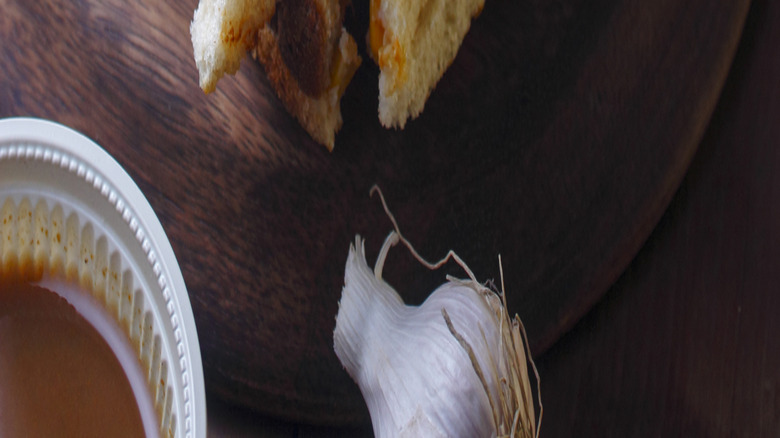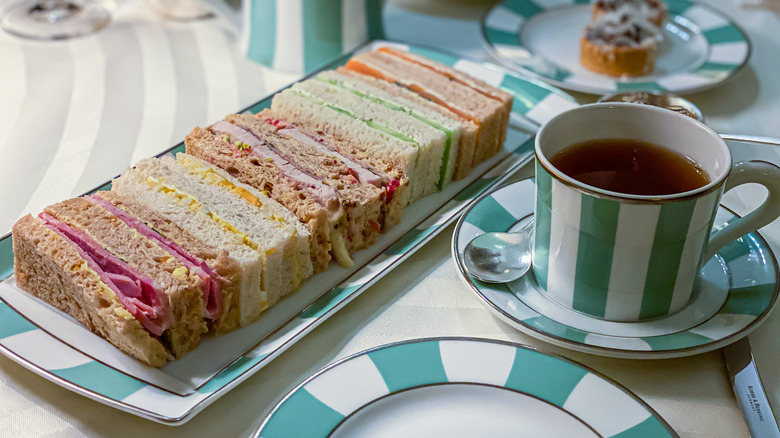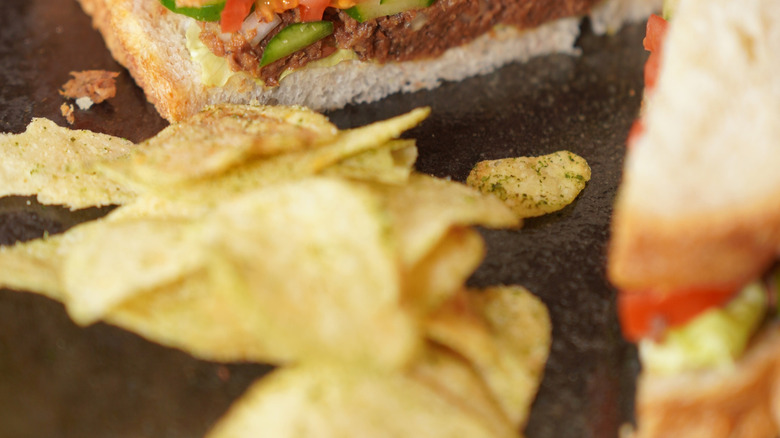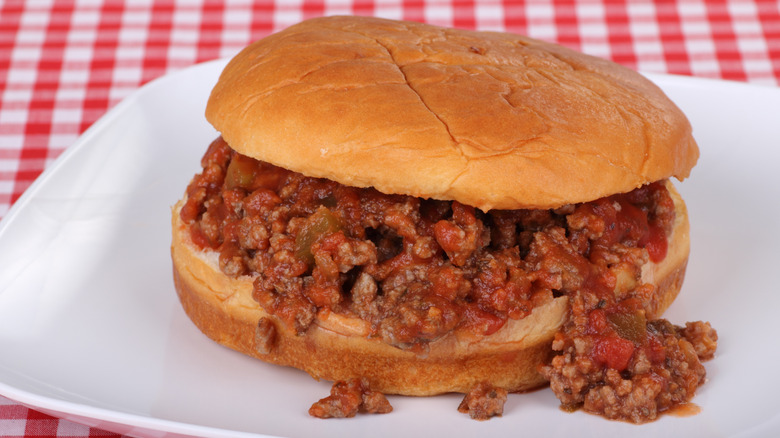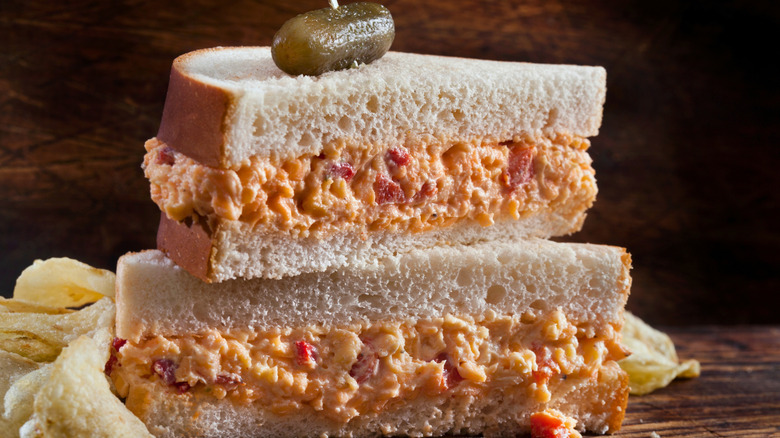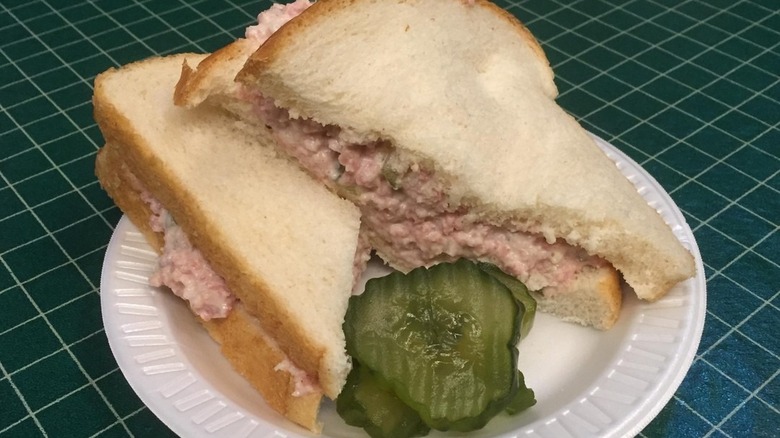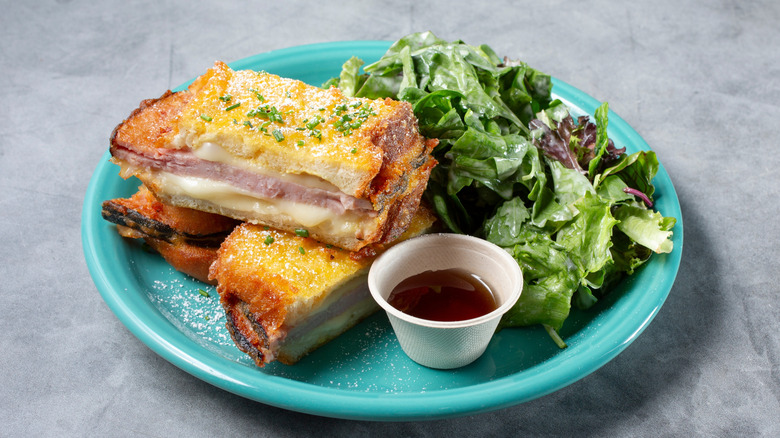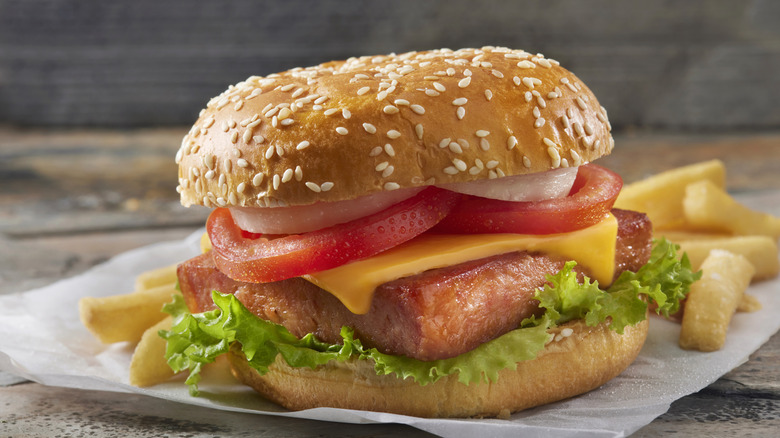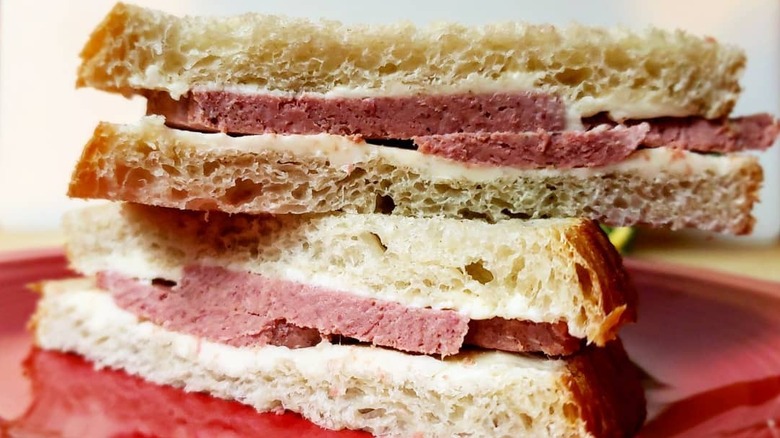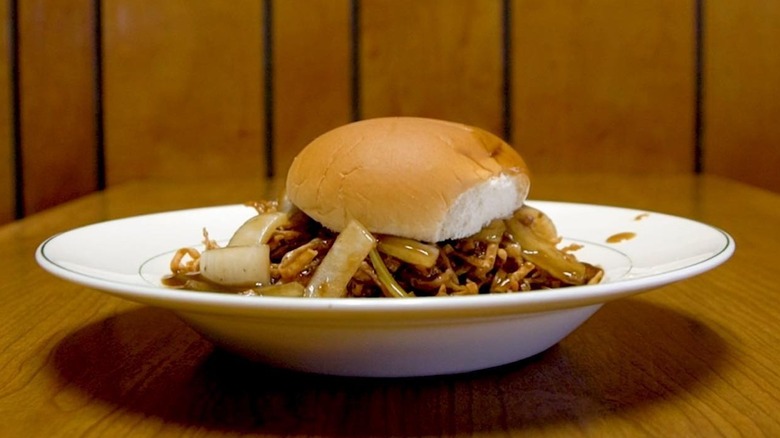Sandwiches That Were Once Popular In The 1950s, Ranked By Healthiness
Sandwiches have been around for a long, long time. Yet, they became quite popular after the invention of sliced bread in the late 1920s as an easy-to-make and portable lunch alternative for kids and husbands alike. However, some historians argue that they truly thrived during the 1950s, in postwar America, a period characterized by being an era of convenience, abundance, and industrialized food production, all of which explain why and how it permanently changed the way the country ate. For example, data from the 2009-2012 What We Eat in America (WWEIA) survey revealed that almost half of Americans eat at least one sandwich a day (via the National Library of Medicine), indicating the long-lasting influence of the decade's cuisine.
Nevertheless, while these sandwiches were once lunchbox staples or party centerpieces, many would raise red flags today. From frosted sandwich loaves created to adorn buffet tables to cold meatloaf sandwiches designed to maximize the use of everyday leftovers, it's relatively easy to note that the decade's sandwich staples reflected an emphasis on taste, affordability, and shelf life rather than nutrition. In fact, according to a study published in Current Developments in Nutrition, data from WWEIA (2009–2012) also showed that, to date, sandwiches remain a significant source of daily sodium and saturated fat. Still, these nostalgic creations remain a fascinating glimpse into mid-century culinary trends and the early days of America's processed food boom.
This article ranks some of the most iconic sandwiches of the 1950s based on modern nutritional science, exploring what makes each sandwich more or less nutritious, their potential health effects, and ways to modify them into healthier modern versions.
Tea sandwiches
Typically made with the crusts cut off and served in bite-sized portions, the delicate yet flavorful tea sandwiches were a staple of 1950s luncheons, garden parties, and bridal showers. Unlike the heavier, meat-packed creations of the era, popular tea sandwiches often featured vegetable-rich fillings like cucumber, tomatoes, or celery, while others included omega-3-packed ingredients such as salmon or tuna, which is why they are marked as the healthiest sandwiches on this list. In fact, when salmon or other fatty fish are the star ingredient, tea sandwiches offer a couple of health bonuses. According to the National Institutes of Health Office of Dietary Supplements, supporting heart health and brain function are just the tip of the iceberg when it comes to the benefits of omega-3 fatty acids, and finding easy yet tasty ways to add them to the menu can help increase their intake in the American diet, which remains low in modern times (per the American Heart Association (AHA)).
However, while the smaller portion sizes help keep calories in check and the use of high-quality fillings promotes a more nutritious dish, the use of refined white bread offers little fiber. Plus, many traditional recipes also call for generous amounts of butter, mayonnaise, or cream cheese to bind ingredients together, which can raise their fat and sodium content. Thus, if you wish to give these classic sandwiches a healthier twist, consider swapping white bread for whole-grain slices and opting for Greek yogurt, mashed avocado, or reduced-fat cream cheese as a binding agent for a creamy texture with less saturated fat.
Sardine sandwich
Sometimes packed straight from the can onto slices of white bread, other times mixed with tomato sauce beforehand, but almost always served with a smear of mayonnaise or mustard and lemon juice, sardine sandwiches were a 1950s treat that offered serious nutritional value. Per a study published in Frontiers in Nutrition, being rich in high-quality protein is only one of the many surprising health benefits of sardines, seeing that they also provide a potent dose of omega-3 fatty acids and a wide range of vitamins and minerals that support both heart and bone health, such as calcium, magnesium, potassium, zinc, phosphorus, and vitamin D.
That said, there is still a little hiccup with this sandwich: its potentially high sodium content. This is because, like most canned goods, sardines can be high in sodium. In fact, one standard can of sardines can contain up to 230 milligrams of the nutrient (via the U.S. Food Database), representing 10% of the recommended daily amount (aka its daily value or DV), per the Food and Drug Administration (FDA). While 10% might not be an alarming sum, when combined with condiments or processed bread, the total sodium content in a sardine sandwich can quickly exceed recommended daily limits, which can be detrimental to your heart health. To modernize this sandwich while still enjoying its health benefits, choose sardines packed in water without added salt, and assemble it on whole-grain or sourdough bread for an added boost of nutrients.
Cold meatloaf sandwich
Meatloaf was a leftover favorite in many 1950s households, making the cold meatloaf sandwich a hearty, no-fuss lunch option. Thanks to its high protein content, meatloaf provides amino acids that support muscle growth, offers long-lasting energy and satiety for weight management, and even contributes to brain health. Additionally, depending on the recipe, it may also include vegetables such as onions, bell peppers, or carrots, and the sandwich itself might feature lettuce and tomato slices, providing a small nutritional boost. However, when viewed from a modern nutritional perspective, some features may raise some eyebrows.
Typically served between slices of white bread, the sandwich offers little fiber beyond that of the veggies included, if any, in the sandwich or the meatloaf recipe itself. Moreover, traditional meatloaf recipes often prefer higher-fat ground meat for a juicier loaf, which can easily increase the sandwich's saturated fat content, a nutrient known for raising blood cholesterol levels and, with it, the risk of heart disease. Additionally, many recipes also include salty seasonings or processed condiments, which can push the sodium content above the recommended amount for a single meal. Combine that with the saturated fat factor, and you've got a sandwich that may be comforting but isn't exactly heart-healthy. To create a more nutritionally balanced version, try preparing meatloaf with lean ground turkey or beef, and pack it with finely chopped vegetables. Swap the breadcrumbs used to bind it for oats or cooked quinoa, and serve it on whole-grain bread.
Sloppy Joes
Known for its sweet-and-savory flavor as well as its messy nature (as implied by its name), the Sloppy Joe was a staple that was, and in some cases still is, a true comfort food classic. Made from ground beef simmered in a tomato-based sauce and served on a soft white bun, this sandwich delivers some nutritional benefits. For starters, the ground beef provides high-quality protein, as well as a variety of vitamins and minerals, such as iron, selenium, zinc, and vitamins B6 and B12. Moreover, the tomato sauce may offer cancer-fighting properties by contributing a dose of lycopene, a powerful antioxidant recognized for its potential in reducing the risk of prostate cancer, especially when coming from cooked tomato sources, per a study published in Prostate Cancer and Prostatic Diseases.
Yet, it's not all rainbows and butterflies when it comes to nutrition with the traditional Sloppy Joe. On the one hand, store-bought sauces or homemade versions using ketchup or barbecue sauce can hide high amounts of added sugar and sodium, which could harm your heart health in the long run. Plus, the refined carbs from the soft bun add virtually no nutrients or fiber. Luckily, there are some easy ways to improve the recipe, including using a homemade sauce, which allows you to control its sugar and sodium levels. You could also serve it on a whole grain bun, or even try a lettuce wrap for a low-carb version with a higher fiber content.
Pimento cheese sandwich
A true Southern staple, the pimento cheese sandwich is made by slathering a creamy blend of shredded cheese, chopped pimentos, and mayo on slices of white bread, creating an easy meal praised for its bold yet comforting flavors. When it comes to its nutritional qualities, the cheese can provide ample protein and calcium, as well as a tummy-friendly alternative for people with lactose intolerance, since cheese is typically better tolerated than milk due to its lower lactose content (per The Nutrition Source). Additionally, pimentos might deliver small amounts of vitamin C and antioxidants. However, that's about it when it comes to this 1950s staple, as the overall nutritional profile of the traditional pimento cheese sandwich can raise plenty of concerns.
Starting with its fat content, although it can vary depending on the type of shredded cheese used, The Nutrition Source notes that cheese can still be a significant source of saturated fat, since approximately 70% of the fat in full-fat dairy is saturated. Plus, when combined with the generous amount of mayonnaise needed to achieve its creamy consistency, the sandwich can easily become a cholesterol-raising bomb, potentially increasing the risk of heart disease when consumed in excess. However, this doesn't mean you have to kiss your pimento cheese sandwich goodbye. By using low-fat cheese and opting for other creamy alternatives to mayo, such as Greek yogurt, you can easily reduce the less healthy aspects of the sandwich while keeping it tasty and nutritious.
Bologna salad sandwich
Often made by blending slices of bologna with hard-boiled eggs, mayo, pickles, and seasonings and served cold between slices of white bread, the bologna salad sandwich was a creamy, tangy, and salty creation common in 1950s lunchboxes. Yet, beyond its convenience and ease of preparation, this sandwich offers little in terms of nutritional value. On the contrary, there are several reasons why you should think twice before eating deli meat like bologna. Starting with its ultra-processed nature, bologna contains food additives that have been linked to health concerns. For example, sodium nitrite, a preservative used in deli meats, has been extensively associated with certain cancers in humans, including stomach, colon, and rectal cancers (via NutritionFacts.org).
Moreover, it also contains high amounts of sodium and added sugars, earning it the label of a high-concern ingredient per the Environmental Working Group's Food Score. Thus, when combined with mayo and served on white bread, the bologna salad sandwich quickly becomes a calorie-dense and nutrient-poor option. To create a healthier version of this retro favorite, consider replacing the bologna with lean turkey or chicken breast, or even trying a mashed chickpea salad for a plant-based alternative. Lastly, swap mayonnaise for plain Greek yogurt and serve on your preferred high-fiber bread for a more balanced meal.
Frosted sandwich loaf
While the frosted sandwich loaf can be described as the most eye-catching of all the mid-century favorites, this edible centerpiece scores high on looks but low on nutrition. Shaped like a rectangular cake, achieved either by horizontally slicing an uncut loaf of white bread or placing multiple slices of bread in a row, the sandwich featured multiple layers of sandwich fillings (such as ham, egg, and chicken salads) stacked between the bread slices, frosted with a thick layer of cream cheese, mayonnaise, or a mix of the two, and garnished with colorful vegetables cut in varying shapes and sizes.
Despite including protein-rich ingredients, many of the fillings relied on salads made out of processed meats, meaning the frosted sandwich loaf was often a calorie-dense dish containing lots of additives, saturated fat, and sodium, an unhealthy mix that can increase the risk of heart disease and cancer, as registered dietitian Julia Zumpano, RD, LD, explains via the Cleveland Clinic. Fortunately, by replacing traditional fillings with options like mashed or roasted vegetables, heart-healthy fatty fish-based salads (think salmon, sardines, or tuna), relying on mashed avocado or yogurt as binders, and swapping the usual full-fat cream cheese frosting for a lighter, dairy-free option like this homemade vegan cream cheese, you get to modernize the recipe into a far more balanced option while keeping its charming vintage appeal.
Monte Cristo sandwich
Have you ever thought about combining a classic ham and cheese sandwich with French toast? Well, that's pretty much what the 1950s Monte Cristo sandwich consisted of. Typically made by layering processed meats, such as ham and turkey, with Swiss cheese between slices of white bread, then dipped in egg batter to be pan- or deep-fried, and often dusted with powdered sugar or served with jam or honey, this undeniably flavorful sandwich easily blurred the line between breakfast and lunch. However, it's easy to see how the decadent, savory-sweet dish prioritizes flavor over health, given its numerous nutritional pitfalls.
For starters, processed deli meats contribute significant amounts of sodium and preservatives. Meanwhile, refined carbs in the bread and sweet toppings increase the energy load and spike blood sugar levels. According to Harvard Health Publishing, these two dietary factors can significantly increase the risk of heart disease. In fact, the site recommends eliminating both processed meats and refined carbs from your diet completely, or at least keeping their intake to a minimum. Moreover, the frying process raises several additional nutritional concerns, including increased trans fat intake and inflammation, which further compromise heart health. To reinvent this sandwich into a heart-healthy version, opt for low-sodium deli meats, a low-fat cheese, and whole-grain bread. Instead of frying it, try grilling or air-frying it, and replace the toppings with a fruit spread with no added sugars or fresh fruit slices for natural sweetness.
SOS (creamed chipped beef on toast)
Nicknamed "SOS" (short for "Same Old Stuff," among other more colorful interpretations), the creamed chipped beef on toast was an open sandwich popular among the 1950s military crowd that made its way into American households. The budget-saving dish featured thin slices of dried beef in a creamy white gravy, poured over toasted white bread. Yet, while being able to fill most bellies, its ingredients leave much to be desired healthwise. For example, both the dried beef and cream-based gravy pack great amounts of unhealthy saturated fats and sodium, making this sandwich a high-risk choice for heart health, as saturated fats increase your risk of atherosclerosis, while sodium increases the chances of developing high blood pressure.
Nevertheless, there are a couple of tweaks you can make to the recipe to decrease your risk of heart disease while still indulging in the sandwich's nostalgic feel. To start, begin by replacing the dried beef with chopped lean turkey or chicken breast slices, which provide protein with a lower sodium and fat count. Make a heart-friendly gravy using low-fat milk and thickened with whole wheat flour instead of heavy cream or butter. Lastly, serve it over whole-grain or sourdough bread for a sprinkle of fiber and nutrients.
Spam sandwich
Spam sandwiches were made by pan-frying a thick slice of Spam until crisp and layering it between slices of white bread or halved sweet buns, with various additional ingredients, such as lettuce, pickles, tomato, or scrambled eggs, depending on personal preference. Spam is a tinned product made from pork meat that became a popular diet item in different parts of the country during the Second World War due to its practicality and long shelf life. However, those qualities are usually precisely what deem a product as less nutritious, as they are a direct result of the use of not-so-healthy ingredients, like sodium and saturated fats, which are known dietary elements that increase the risk of heart disease (via Better Health).
For example, a 2-ounce serving of Spam packs a whopping 790 milligrams of sodium and almost 6 grams of saturated fats (per the USDA Food Database), accounting for 34% and 30% of the DV for the respective nutrients (via the FDA). When considering that the AHA recommends keeping your sodium intake below 1,500 milligrams daily and your saturated fat intake under 6% of your total calories (per the AHA), this sandwich starts to look like trouble for your heart.
Braunschweiger sandwich
Back in the 1950s, the Braunschweiger sandwich was made by layering thick slices of Braunschweiger sausage (a pâté-style sausage made from pork liver) on soft white bread and topping it with cheese, onions, pickles, and condiments like mustard and mayo. Because its star ingredient is made from liver, the organ that stores most of the body's vitamins and minerals, it is surprisingly nutrient-dense, packing remarkably high amounts of high-quality protein, iron, vitamin A, and B vitamins. However, it also comes with a set of health drawbacks that can threaten your heart and bone health if consumed often, which is why it earned its place near the end of this list.
Food items like pâtés are also classified as a type of processed meat, and as such, they can increase your chances of developing high blood pressure and colon cancer when consumed in excess. This is due to their high levels of cholesterol, sodium, and food additives. Plus, overindulging in liver products could potentially lead to vitamin A toxicity, which could lead to brittle bones in the long run. To enjoy the essence of this sandwich without compromising your overall health, consider using smaller portions of Braunschweiger and pairing it with fiber-rich whole-grain bread to help balance the meal.
Chow mein sandwich
Featuring a generous scoop of starchy chow mein noodles (sometimes even deep-fried for added crunch), topped with a salty, savory gravy, often including bits of meat and vegetables, and served between the halves of a white hamburger bun, the Chow Mein sandwich may be one of the most unusual creations of mid-20th-century America, and the least nutritionally balanced. For starters, the sandwich is pretty much comprised exclusively of refined carbs from both the noodles and the bread, providing virtually no fiber for gut health, weight management, or blood sugar control, an issue within the American diet that has prevailed throughout modern times, as noted in an article published in Nutrients. Plus, gravy tends to be high in sodium, and when meat is included, which is often also fried, it adds to the sandwich's not-so-heart-friendly nature.
Some easy ways to modernize this sandwich would be to swap traditional noodles for whole-grain or brown rice noodles to increase its fiber content, use a broth-based gravy to reduce its saturated fat count, and serve it on a whole-grain bun or lettuce wrap for a more balanced, heart-smart twist.
